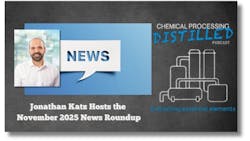Podcast: Chemical industry braces for turbulent year ahead -- November 2025 News
Welcome to Distilled News, where we look back at the top stories each month on Chemicalprocessing.com. I'm Jonathan Katz, executive editor of Chemical Processing.
We begin the November 2025 edition with Deloitte's forecast for the chemical industry in the year ahead.
In its 2026 Chemical Industry Outlook report, Deloitte's Research Center for Energy & Industrials forecast global production growth for thea. chemical industry at 2%, while U.S. output will drop slightly by 0.2%. Overcapacity, soft end-market demand, and trade uncertainty continue pressuring operating rates and margins.
Chemical companies are responding by prioritizing cash flow, restructuring portfolios, and focusing on specialty chemicals, Deloitte reported. Cost controls, including reduced operational and capital expenditures, are supporting liquidity and production continuity.
Demand remains uneven. Construction, automotive and consumer sectors face softness. The semiconductor industry stands out as a bright spot, driven by artificial intelligence and data center growth. Investments in ultra-pure gases, solvents and specialty materials are supporting next-generation chip manufacturing in the U.S. and Europe.
These headwinds echo concerns raised by Martha Gilchrist Moore, the American Chemistry Council's chief economist, who characterized the business environment as a "confused sea state" during her mid-year update for Chemical Processing in June. She cited tariff uncertainty, shifting supply chains, and inconsistent trade policies as factors contributing to the challenges chemical manufacturers face.
Turning to Germany, business sentiment in the country's chemicals industry fell to its lowest level in more than two years in October, Tribune News Service reported on Nov. 10. The ifo Institute's Business Climate Index for the sector dropped 7.4 points to minus 19.4—the lowest reading since July 2023.
"The relief measures taken by the federal government are not sufficient to reverse the trend," said ifo expert Anna Wolf.
The outlook for the future fell 9.6 points to minus 13.3. Rising competition from abroad is forcing German companies to lower prices. More companies now plan to cut prices than raise them, ifo noted.
"The combination of a lack of competitiveness, falling sales prices coupled with high costs and weak orders is forcing companies to cut back on investment and further reduce their workforce," Wolf said.
On the regulatory front, community, health and environmental groups filed a lawsuit Oct. 22 challenging the Trump administration's executive action that exempts 50 chemical manufacturing plants from Clean Air Act protections designed to limit cancer-causing air pollutants.
The suit targets exemptions from EPA's Hazardous Organic National Emission Standards for Hazardous Air Pollutants—the HON NESHAP Rule—which would delay compliance by two years beyond current 2026 and 2027 deadlines. The affected facilities are located across 13 states, including Texas, Louisiana, Illinois and Kentucky.
"We've fought for decades to close loopholes and get real checks on chemical leaks," said Michele Roberts, National Coordinator of Environmental Justice Health Alliance. "Delaying them is a policy choice with a human cost, measured in diagnoses, not dollars."
The exemptions affect regulations controlling ethylene oxide, chloroprene, benzene, 1,3-butadiene, ethylene dichloride and vinyl chloride—all known or suspected carcinogens.
Lynn Bergeson, managing partner of Bergeson & Campbell PC and compliance columnist for Chemical Processing, said the litigation will likely focus on whether EPA acted lawfully in delaying the compliance date. "The delay was based in part on a claim of national security, allowing EPA to invoke the President's authority to exempt certain stationary sources from compliance."
EPA estimates the 2024 HON Rule would cut toxic emissions by more than 6,200 tons annually and reduce air toxics-related cancer risks near these facilities by approximately 96%.
In corporate news, BASF announced Oct. 30 the construction of a new electronic grade ammonium hydroxide plant in Ludwigshafen, Germany, aimed at supplying ultra-pure chemicals for semiconductor manufacturing. The facility is expected to begin operations in 2027, supporting the growth of chip production in Europe.
In a separate move, BASF announced November 3rd it is consolidating its Asian polytetrahydrofuran production into its Caojing site in China and discontinuing production at its Ulsan, South Korea facility by 2026. The move addresses structural changes in the global chemical fiber market and overcapacity challenges.
The announcements come as BASF continues reshaping its portfolio amid challenging market conditions. The company reported a 3.2% decline in third-quarter sales amid weak demand.
Back to regulatory developments, the EPA on Nov. 10 proposed revisions to its reporting regulations for PFAS under the Toxic Substances Control Act. The proposal aims to make PFAS reporting more practical and reduce unnecessary requirements while maintaining the agency's ability to collect essential data.
The updates follow the 2023 PFAS reporting rule, which required companies that manufactured or imported PFAS between 2011 and 2022 to report data related to potential exposure and known health effects.
The proposed rule would add exemptions for PFAS present in mixtures at concentrations of 0.1% or less, imported articles, certain byproducts and impurities, non-isolated intermediates, and research and development substances.
Public comments will be accepted for 45 days following publication in the Federal Register.
And finally, Purdue University researchers have created a new testing method to detect PFAS and speed the discovery of alternative substances. The team produced 915 new PFAS-like molecules from more than 1,000 reactions in a few hours with a 90% success rate.
The researchers employed a. technology developed at Purdue called high-throughput electrospray ionization mass spectrometry. The technology uses charged solvent spray to trigger rapid chemical reactions that can be analyzed in seconds.
Research lead Christina Ferreira said the new method employs a multiuser platform accessible to any researcher to detect, chemically modify or evaluate how these chemicals impact biological systems. The technology also opens a door into making tools that chemically transform PFAS and break them down."
The research team published their findings in Environmental Science & Technology Letters. Purdue has applied for a patent to protect the intellectual property.
That wraps up this edition of Distilled News. Thanks for listening, and I'll be back next month with more news from the chemical industry.
About the Author
Jonathan Katz
Executive Editor
Jonathan Katz, executive editor, brings nearly two decades of experience as a B2B journalist to Chemical Processing magazine. He has expertise on a wide range of industrial topics. Jon previously served as the managing editor for IndustryWeek magazine and, most recently, as a freelance writer specializing in content marketing for the manufacturing sector.
His knowledge areas include industrial safety, environmental compliance/sustainability, lean manufacturing/continuous improvement, Industry 4.0/automation and many other topics of interest to the Chemical Processing audience.
When he’s not working, Jon enjoys fishing, hiking and music, including a small but growing vinyl collection.
Jon resides in the Cleveland, Ohio, area.

